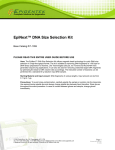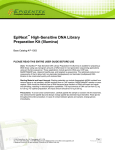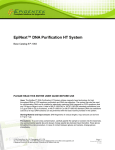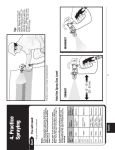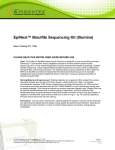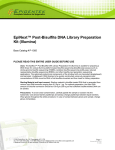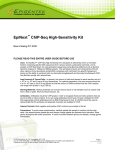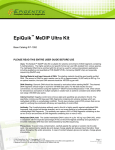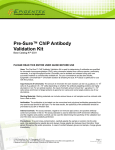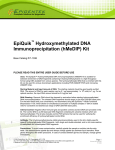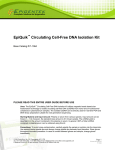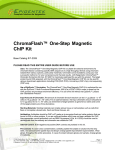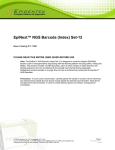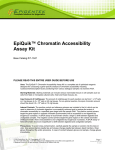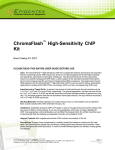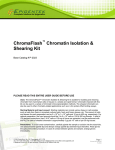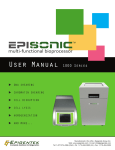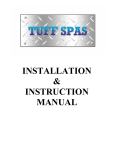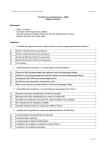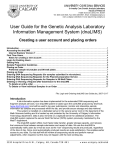Download EpiNext™ DNA Library Preparation Kit (Illumina)
Transcript
EPIGENTEK Complete Solutions for Epigenetics EpiNext™ DNA Library Preparation Kit (Illumina) Base Catalog # P-1051 PLEASE READ THIS ENTIRE USER GUIDE BEFORE USE Uses: The EpiNext™ DNA Library Preparation Kit (Illumina) is suitable for preparing a DNA library for next generation sequencing applications using an Illumina sequencer, which includes genomic DNAseq, ChIP-seq, MeDIP/hMeDIP-seq, bisulfite-seq, and targeted re-sequencing. The optimized protocol and components of the kit allow both non-barcoded (singleplexed) and barcoded (multiplexed) DNA libraries to be constructed quickly with reduced bias. Starting Material and Input Amount: Starting materials can include fragmented dsDNA isolated from various tissue or cell samples, dsDNA enriched from ChIP reaction, MeDIP/hMeDIP reaction or exon capture. DNA should be relatively free of RNA since large fractions of RNA will impair end repair and dA tailing, resulting in reduced ligation capabilities. Input amount of DNA can be from 5 ng to 1 ug. For optimal preparation, the input amount should be 100 ng to 200 ng. For amplification-free, 500 ng or more is needed. Precautions: To avoid cross-contamination, carefully pipette the sample or solution into the tube/vials. Use aerosol-barrier pipette tips and always change pipette tips between liquid transfers. Wear gloves throughout the entire procedure. In case of contact between gloves and sample, change gloves immediately. 110 Bi County Blvd. Ste. 122, Farmingdale, NY 11735 Tel: 1-877-374-4368 ■ Fax: 1-718-484-3956 ■ E-mail: [email protected] ■ Web: www.epigentek.com © Epigentek Group Inc. All rights reserved. Products are for research use only. Page 1 Printed 2013-12-31 P-1051 EPIGENTEK Complete Solutions for Epigenetics KIT CONTENTS Component 12 reactions Cat. #P-1051-12 24 reactions Cat. #P-1051-24 Storage Upon Receipt 10X End Repair Buffer* End Repair Enzyme Mix* 10X dA-Tailing Buffer* Klenow Fragment (3’-5’ exo-)* 2X Ligation Buffer* T4 DNA Ligase* Adaptors (50 µM)* MQ Binding Beads* 2X HiFi PCR Master Mix* Primer U (10 µM)* Primer I (10 µM)* Elution Buffer* User Guide 40 µl 25 µl 40 µl 15 µl 250 µl 15 µl 15 µl 1.6 ml 160 µl 15 µl 15 µl 1000 µl 1 80 µl 50 µl 80 µl 30 µl 500 µl 30 µl 30 µl 3.2 ml 320 µl 30 µl 30 µl 2000 µl 1 -20°C -20°C -20°C -20°C -20°C -20°C -20°C 4°C -20°C -20°C -20°C -20°C RT * Spin the solution down to the bottom prior to use. SHIPPING & STORAGE The kit is shipped on frozen ice packs at 4°C. Upon receipt: Store the following components at -20°C immediately: 10X End Repair Buffer, End Repair Enzyme Mix,10X dA-Tailing Buffer, Klenow Fragment (3’-5’ exo-), 2X Ligation Buffer, T4 DNA Ligase, Adaptors, 2X HiFi PCR Master Mix, Primer U, Primer I, and Elution Buffer. Store the following components at 4°C: MQ Binding Beads. Store all other components at room temperature. MATERIALS REQUIRED BUT NOT SUPPLIED Vortex mixer Sonicator or enzymes for DNA fragmentation Agilent® Bioanalyzer® or comparable method to assess the quality of DNA library Thermocycler Centrifuge including desktop centrifuge (up to 14,000 rpm) Magnetic stand (96-well format) Pipettes and pipette tips PCR tubes or plates 1.5 ml microcentrifuge tubes 100% ethanol 110 Bi County Blvd. Ste. 122, Farmingdale, NY 11735 Tel: 1-877-374-4368 ■ Fax: 1-718-484-3956 ■ E-mail: [email protected] ■ Web: www.epigentek.com © Epigentek Group Inc. All rights reserved. Products are for research use only. Page 2 Printed 2013-12-31 P-1051 EPIGENTEK Complete Solutions for Epigenetics Distilled water DNA sample GENERAL PRODUCT INFORMATION Quality Control: Each lot of EpiNext™ DNA Library Preparation Kit (Illumina) is tested against predetermined specifications to ensure consistent product quality. Epigentek guarantees the performance of all products in the manner described in our product instructions. Product Warranty: If this product does not meet your expectations, simply contact our technical support unit or your regional distributor. We also encourage you to contact us if you have any suggestions about product performance or new applications and techniques. Safety: Suitable lab coat, disposable gloves, and proper eye protection are required when working with this product. Product Updates: Epigentek reserves the right to change or modify any product to enhance its performance and design. The information in this User Guide is subject to change at any time without notice. Thus, only use the User Guide that was supplied with the kit when using that kit. Usage Limitation: The EpiNext™ DNA Library Preparation Kit (Illumina) is for research use only and is not intended for diagnostic or therapeutic application. Intellectual Property: The EpiNext™ DNA Library Preparation Kit (Illumina) and methods of use contain proprietary technologies by Epigentek. A BRIEF OVERVIEW DNA library preparation is a critical step for next generation sequencing (NGS). For generating accurate sequencing data for NGS, the prepared library DNA should be sufficient in yield and of high quality. Also, as NGS technology is continuously improving, DNA library preparation is required to be optimized accordingly. For example, most of the currently used methods are time-consuming, expensive and inconvenient. Some of the methods are relatively quick by combining end repair and dA tailing or even ligation in one-step. However, these methods have been shown to generate significant G tailing or form concatemers at the ligation step or to have high insertion bias. These side reactions eventually result in the prepared DNA library being less efficient and inaccurate. An ideal DNA library preparation method should be balanced in speed, convenience, small sample-suitability, costeffectiveness and accuracy. To address this issue, Epigentek offers the EpiNext™ DNA Library Preparation Kit (Illumina). This kit has the following features: Fast and streamlined procedure: The procedure from fragmented DNA to size selection is less than 2 h 30 min. Only one clean-up between each step, thereby saving time and preventing handling errors, as well as loss of valuable samples. Gel-free size selection further reduces the preparation time. The most convenient for use: The kit contains all required components for each step of DNA library preparation, which are sufficient for end repair, dA tailing, ligation, clean-up, size selection and library amplification, thereby allowing the library preparation to be convenient with reliable and consistent results. Minimized bias: Ultra HiFi amplification and an optional PCR-free step enable the user to achieve reproducibly high yields of DNA library with minimal sequence bias and low error rates. 110 Bi County Blvd. Ste. 122, Farmingdale, NY 11735 Tel: 1-877-374-4368 ■ Fax: 1-718-484-3956 ■ E-mail: [email protected] ■ Web: www.epigentek.com © Epigentek Group Inc. All rights reserved. Products are for research use only. Page 3 Printed 2013-12-31 P-1051 EPIGENTEK Complete Solutions for Epigenetics Flexibility: Can be used for both non-barcoded (singleplexed) and barcoded (multiplexed) DNA library preparation. Uses various dsDNA including fragmented dsDNA isolated from various tissue or cell samples, dsDNA enriched from ChIP reactions, MeDIP/hMeDIP reactions or exon capture. Broad range of input DNA from 5 ng to 1 µg. PCR-free library preparation can be performed with use of 500 ng or more input DNA. PRINCIPLE & PROCEDURE The EpiNext™ DNA Library Preparation Kit (Illumina) contains all reagents required at each step for carrying out successful DNA library preparation. In the library preparation, DNA is first fragmented to the appropriate size (about 300 bp peak size). The end repair of the DNA fragments is performed and an A-overhang is added at the 3'-end of each strand. Adaptors are then ligated to both ends of the end repaired/dA tailed DNA fragments for amplification and sequencing. Fragments are then size selected and purified with MQ beads, which allows quick and precise size selection of DNA. Sizeselected DNA fragments are then amplified with a high-fidelity PCR Mix which ensures maximum yields from minimum amounts of starting material and provides highly accurate amplification of library DNA with low error rates and minimum bias. Fragmented input DNA End Repair dA Tailing 5 3 ’3 ’ ’5 ’ Adaptor Ligation Size Selection Amplification Next Generation Sequencing Fig 1. Workflow of the EpiNext™ DNA Library Preparation Kit (Illumina) 110 Bi County Blvd. Ste. 122, Farmingdale, NY 11735 Tel: 1-877-374-4368 ■ Fax: 1-718-484-3956 ■ E-mail: [email protected] ■ Web: www.epigentek.com © Epigentek Group Inc. All rights reserved. Products are for research use only. Page 4 Printed 2013-12-31 P-1051 EPIGENTEK Complete Solutions for Epigenetics Fig2. Size distribution of library fragments. Human placenta DNA was sheared to 210 bps in peak size and 20 ng of sheared DNA was used for DNA library preparation using EpiNext™ DNA Library Preparation Kit (Illumina). ASSAY PROTOCOL For the best results, please read the protocol in its entirety prior to starting your experiment. Starting Materials Fragmented dsDNA that is isolated from various tissues or cell samples: 5 ng-1 µg, optimal 100-200 ng per preparation. For amplification-free, 500 ng or more of DNA is needed. dsDNA enriched from ChIP reactions, MeDIP/hMeDIP reactions or exon capture: 5 ng-500 ng. DNA should be high quality relatively free of RNA. RNAse I can be used to remove RNA and DNA should be eluted in DNase/RNase-free water. DNA Fragmentation dsDNA enriched from ChIP reactions, MeDIP/hMeDIP reactions or exon capture should be fragmented already. DNA isolated from various tissue or cell samples can be fragmented using one of the following methods. For the best results we highly recommend to use waterbath-based sonication device. The peak size of fragmented DNA should be compatible with the read length of the Illumina sequencing platform to be used. In general the peak size of fragments should be about 300 bps. Waterbath Sonication: Epigentek’s EpiSonic 1100 (Epigentek Cat No. EQC-1100): For a target peak size of 300 bps, use 20 µl of DNA solution (50-500 ng) per 0.2 ml tube or per PCR plate well. Shear 60 cycles under cooling conditions, 30 seconds ON, 15 seconds OFF, each at 120-130 watts. For more detailed information of use, please see the “DNA Shearing Protocol” for EpiSonic 1100. If using other waterbath sonicators please follow the supplier’s recommended instructions. 110 Bi County Blvd. Ste. 122, Farmingdale, NY 11735 Tel: 1-877-374-4368 ■ Fax: 1-718-484-3956 ■ E-mail: [email protected] ■ Web: www.epigentek.com © Epigentek Group Inc. All rights reserved. Products are for research use only. Page 5 Printed 2013-12-31 P-1051 EPIGENTEK Complete Solutions for Epigenetics Enzymatic Shearing: The DNA can also be sheared using various enzyme-based methods. Optimization of the shearing conditions, for example enzyme concentration and incubation time, is needed in order to use enzymebased methods. 1. DNA End Repairing a. Prepare end repair reaction in a 0.2 ml PCR tube according to Table 1: Table 1. End Repair Reaction Component Fragmented DNA (5-500 ng)* Volume 2-10 µl 10X End Repair Buffer End Repair Enzyme Mix Distilled Water Total volume 2 µl 1 µl 7-15 µl 20 µl Note: *The optimized amount of fragmented DNA is 100-200 ng b. Mix and incubate for 30 min at 20°C in a thermocycler (without a heated lid). 2. Clean-up of End Repaired DNA a. b. c. d. e. f. g. h. i. j. Resuspend MQ Binding Beads by vortex. Add 36 μl of resuspended beads to the PCR tube of end repair reaction. Mix thoroughly on a vortex mixer or by pipetting up and down at least 10 times. Incubate for 10 minutes at room temperature to allow DNA to bind to beads. Put the PCR tube on an appropriate magnetic stand until the solution is clear (about 4 minutes). Carefully remove and discard the supernatant. (Caution: Be careful not to disturb or discard the beads that contain DNA.) Keep the PCR tube in the magnetic stand and add 200 μl of freshly prepared 80% ethanol to the tube. Incubate at room temperature for 1 min, and then carefully remove and discard the ethanol. Repeat Step 2e for a total of two washes. Open the cap of the PCR tube and air dry beads for 10 minutes while the tube is on the magnetic stand. Resuspend the beads in 12 µl Elution Buffer, and incubate at room temperature for 2 minutes to release the DNA from the beads. Capture the beads by placing the tube in the magnetic stand for 4 minutes or until the solution is completely clear. Transfer 11-12 ul of the supernatant to a new 0.2 ml PCR tube for the dA-tailing reaction. 3. DNA dA-Tailing a. Prepare the reaction mix for dA tailing according to Table 2. Add the following reagents to 0.2 ml PCR tube containing end repaired DNA from Step 1. 110 Bi County Blvd. Ste. 122, Farmingdale, NY 11735 Tel: 1-877-374-4368 ■ Fax: 1-718-484-3956 ■ E-mail: [email protected] ■ Web: www.epigentek.com © Epigentek Group Inc. All rights reserved. Products are for research use only. Page 6 Printed 2013-12-31 P-1051 EPIGENTEK Complete Solutions for Epigenetics Table 2. dA-Tailing Reaction Component End repaired DNA (from step 2) 10X dA-Tailing Buffer Klenow Fragment (3’-5’ exo-) Distilled Water Total Volume b. Volume 11-12 µl 1.5 µl 1 µl 0.5-1.5 µl 15 µl Mix and incubate for 30 min at 37°C followed by 10 min at 75°C in a thermocycler (without heated lid). 4. Adaptor Ligation a. Prepare a reaction mix for adaptor ligation according to Table 3. Add the following reagents to a 0.2 ml PCR tube containing end repaired/dA-Tailing DNA from Step 3. Table 3. Adaptor Ligation Component End repaired/dA-Tailing DNA (from step 3) 2X Ligation Buffer T4 DNA Ligase Adaptors Total volume b. Volume 15 µl 17 µl 1 µl 1 µl 34 µl Mix and incubate for 10 min at 25°C in a thermocycler (without heated lid). Note: (1) The pre-annealed adapters included in the kit are suitable for both non-barcoded (singleplexed) and barcoded (multiplexed) DNA library preparation and are fully compatible with Illumina platforms, such as MiSeq® or HiSeq™ sequencers. (2) If using adaptors from other suppliers (both single-end and barcode adaptors), make sure they are compatible with Illumina platforms and add the correct amount (final concentration 1.5-2 µM, or according to the supplier’s instruction). 5. Size Selection/Clean-up 5.1. Size Selection of Ligated DNA Note: If the starting DNA amount is less than 50 ng, the size selection is not recommended and alternatively, clean-up of ligated DNA can be performed prior to PCR amplification according to section 5.2 of the user guide. a. b. c. d. e. Resuspend MQ Binding Beads by vortex. Add 14 µl of resuspended MQ Binding Beads to the tube of ligation reaction. Mix well by pipetting up and down at least 10 times. Incubate for 5 minutes at room temperature. Put the tube on an appropriate magnetic stand until the solution is clear (about 4 minutes). Carefully transfer the supernatant containing DNA to a new tube (Caution: Do not discard the supernatant.) Discard the beads that contain the unwanted large fragments. Add 10 µl resuspended beads to the supernatant, mix well and incubate for 5 minutes at room temperature. 110 Bi County Blvd. Ste. 122, Farmingdale, NY 11735 Tel: 1-877-374-4368 ■ Fax: 1-718-484-3956 ■ E-mail: [email protected] ■ Web: www.epigentek.com © Epigentek Group Inc. All rights reserved. Products are for research use only. Page 7 Printed 2013-12-31 P-1051 EPIGENTEK Complete Solutions for Epigenetics f. g. h. i. j. k. l. Put the PCR tube on an appropriate magnetic stand until the solution is clear (about 4 minutes). Carefully remove and discard the supernatant. (Caution: Be careful not to disturb or discard the beads that contain DNA.) Keep the PCR tube in the magnetic stand and add 200 μl of freshly prepared 80% ethanol to the tube. Incubate at room temperature for 1 min, and then carefully remove and discard the ethanol. Repeat Step 5.1g for a total of two washes. Open the PCR tube cap and air dry beads for 10 minutes while the tube is on the magnetic stand. Resuspend the beads in 12 µl Elution Buffer, and incubate at room temperature for 2 minutes to release the DNA from the beads. Capture the beads by placing the tube in the magnetic stand for 4 minutes or until the solution is completely clear. Transfer 11 µl of supernatant to a new 0.2 ml PCR tube for PCR amplification. 5.2. Clean-up of Ligated DNA (Optional) a. b. c. d. e. f. g. h. i. j. Resuspend MQ Binding Beads by vortex. Add 34 μl of resuspended beads to the PCR tube of ligation reaction. Mix thoroughly on a vortex mixer or by pipetting up and down at least 10 times. Incubate for 5 minutes at room temperature to allow DNA to bind to beads. Put the PCR tube on an appropriate magnetic stand until the solution is clear (about 4 minutes). Carefully remove and discard the supernatant. (Caution: Be careful not to disturb or discard the beads that contain DNA.) Keep the PCR tube in the magnetic stand and add 200 μl of freshly prepared 80% ethanol to the tube. Incubate at room temperature for 1 min, and then carefully remove and discard the ethanol. Repeat Step 5.2e two times for a total of three washes. Open the PCR tube cap and air dry beads for 10 minutes while the tube is on the magnetic stand. Resuspend the beads in 12 µl Elution Buffer, and incubate at room temperature for 2 minutes to release the DNA from the beads. Capture the beads by placing the tube in the magnetic stand for 4 minutes or until the solution is completely clear. Transfer 11 µl of supernatant to a new 0.2 ml PCR tube for PCR amplification. If the library is prepared using 500 ng or more input DNA, the library DNA can be directly used for sequencing application after size selection. Otherwise, go to Step 6 for PCR amplification. 6. Library Amplification a. Prepare the PCR Reactions Thaw all reaction components including 2X HiFi PCR Master Mix, primers and DNA template. Mix well by vortexing briefly. Keep components on ice while in use, and return to –20˚C immediately following use. Add components into each PCR tube/well according to the following table: Component Size (:l) Final Concentration Component Size (µl) 2X HiFi PCR Master Mix 12.5 µl Primer U 1 µl Primer I (or barcode) 1 µl Adaptor Ligated DNA 10.5 µl Total Volume 25 µl 110 Bi County Blvd. Ste. 122, Farmingdale, NY 11735 Tel: 1-877-374-4368 ■ Fax: 1-718-484-3956 ■ E-mail: [email protected] ■ Web: www.epigentek.com © Epigentek Group Inc. All rights reserved. Products are for research use only. Page 8 Printed 2013-12-31 P-1051 EPIGENTEK Complete Solutions for Epigenetics Important Note: Use of Primer I included in the kit will generate a singleplexed library. For multiplexed library preparation, replace Primer I with one of the12 different barcodes (indexes) contained in the EpiNextTM NGS Barcode (Index) Set-12 (Cat. No. P-1060). You can also add userdefined barcodes (Illumina compatible) instead of Primer I. b. Program the PCR Reactions Place the reaction plate in the instrument and set the PCR conditions as follow: Cycle Step Temp Time Cycle Activation 98°C 30 sec 1 Cycling 98°C 55°C 72°C 10 sec 15 sec 20 sec Variable* Final Extension 72°C 1 min 1 * PCR cycles may vary depending on the input DNA amount. In general, use 8 PCR cycles for 500 ng, 12 cycles for 50 ng, and 16 cycles for 5 ng DNA input. Further optimization of PCR cycle number may be required. 7. Clean-up of Amplified Library DNA a. b. c. d. e. f. g. h. i. j. Resuspend MQ Binding Beads by vortex. Add 25 μl of resuspended beads to the PCR tube of amplification reaction. Mix thoroughly on a vortex mixer or by pipetting up and down at least 10 times. Incubate for 5 minutes at room temperature to allow DNA to bind to beads. Put the PCR tube on an appropriate magnetic stand until the solution is clear (about 4 minutes). Carefully remove and discard the supernatant. (Caution: Be careful not to disturb or discard the beads that contain DNA.) Keep the PCR tube in the magnetic stand and add 200 μl of freshly prepared 80% ethanol to the tube. Incubate at room temperature for 1 min, and then carefully remove and discard the ethanol. Repeat Step 7e two times for total of three washes. Open the PCR tube cap and air dry beads for 10 minutes while the tube is on the magnetic stand. Resuspend the beads in 22 µl Elution Buffer, and incubate at room temperature for 2 minutes to release the DNA from the beads. Capture the beads by placing the tube in the magnetic stand for 4 minutes or until the solution is completely clear. Transfer 20 µl of supernatant to a new 0.2 ml PCR tube. Quality of the prepared library can be assessed using an Agilent® Bioanalyzer® or a comparable method. Library fragments should have the correct size distribution (ex: 300 bps at peak size) without adaptors or adaptor-dimers. To check the size distribution, dilute library 5-fold with water and apply it to an Agilent® high sensitivity chip. If there is presence of <150 bp adaptor dimers or of larger fragments than expected, they should be removed. To remove fragments below 150 bps use 0.8X MQ Binding Beads Beads (ex: add 16 μl of MQ Binding Beads to 20 μl of sample) according to sub-steps a through i of Step 5.2 “Clean-up of Ligated DNA”. To remove fragments above 500 bps follow sub-steps a through l of Step 5.1 “Size Selection of Ligated DNA”. The prepared DNA library can be quantified using various DNA library quantification methods. 110 Bi County Blvd. Ste. 122, Farmingdale, NY 11735 Tel: 1-877-374-4368 ■ Fax: 1-718-484-3956 ■ E-mail: [email protected] ■ Web: www.epigentek.com © Epigentek Group Inc. All rights reserved. Products are for research use only. Page 9 Printed 2013-12-31 P-1051 EPIGENTEK Complete Solutions for Epigenetics The prepared library DNA can be stored at -20˚C until ready to use for sequencing. TROUBLESHOOTING Problem Possible Cause Suggestion Low yield of library Insufficient amount of starting DNA. To obtain the best results, the amount of input DNA should be 100-200 ng. For library directly used for sequencing without amplification, 500 ng or more is needed. Insufficient purity of starting DNA. Ensure that RNA is removed by RNase treatment before starting library preparation protocol. Improper reaction conditions at each reaction step. Check if the reagents are properly added and incubation temperature and time are correct at each reaction step including End Repair, dA Tailing, Adaptor Ligation, Size Selection and Amplification. Improper kit storage. Ensure that the kit has not exceeded the expiration date. Standard shelf-life, when stored properly, is 6 months from date of receipt. Improper ratio of MQ beads to DNA volume during size selection. Check if the correct volume of MQ beads is added to the DNA solution accordingly. Proper ratios should remove the fragments of unexpected peak size. See Step 7 for more details. Insufficient ligation. Too much or too little input DNA may cause insufficient ligation, which can shift the peak size of the fragment population to be shorter or larger than expected. Make sure that the ligation reaction is properly processed using the proper amount of input DNA. Over-amplification of library. PCR artifacts from over-amplification of the library may cause the fragment population to shift higher than expected. Make sure to use proper PCR cycles to avoid this problem. Unexpected peak size of Agilent® Bioanalyzer® trace: Presence of <150 bp adaptor dimers or presence of larger fragments than expected. RELATED PRODUCTS DNA Isolation and Cleanup P-1003 FitAmp™ General Tissue Section DNA Isolation Kit P-1004 FitAmp™ Plasma/Serum DNA Isolation Kit 110 Bi County Blvd. Ste. 122, Farmingdale, NY 11735 Tel: 1-877-374-4368 ■ Fax: 1-718-484-3956 ■ E-mail: [email protected] ■ Web: www.epigentek.com © Epigentek Group Inc. All rights reserved. Products are for research use only. Page 10 Printed 2013-12-31 P-1051 EPIGENTEK Complete Solutions for Epigenetics P-1006 P-1007 P-1009 P-1017 P-1018 DNA Concentrator Kit FitAmp™ Gel DNA Isolation Kit FitAmp™ Paraffin Tissue Section DNA Isolation Kit FitAmp™ Urine DNA Isolation Kit FitAmp™ Blood and Cultured Cell DNA Extraction Kit Sonication Instruments EQC-1100 EpiSonic™ Multi-Functional Bioprocessor 1100 DNA Enrichment Reaction P-1015 Methylamp™ Methylated DNA Capture (MeDip) Kit P-1038 EpiQuik™ Hydroxymethylated DNA Immunoprecipitation (hMeDIP) Kit P-1052 EpiQuik™ MeDIP Ultra Kit P-2002 EpiQuik™ Chromatin Immunoprecipitation (ChIP) Kit P-2003 EpiQuik™ Tissue Chromatin Immunoprecipitation (ChIP) Kit P-2014 EpiQuik™ Plant ChIP Kit P-2025 ChromaFlash™ One-Step ChIP Kit P-2026 ChromaFlash™ One-Step Magnetic ChIP kit P-2027 ChromaFlash™ High-Sensitivity ChIP Kit DNA Bisulfite Conversion P-1001 Methylamp™ DNA Modification Kit P-1026 BisulFlash™ DNA Modification Kit DNA Library Prep P-1053 EpiNext™ High-Sensitivity DNA Library Preparation Kit (Illumina) P-1055 EpiNext™ Post-Bisulfite DNA Library Preparation Kit (Illumina) P-1056 EpiNext™ Bisulfite-Seq High Sensitivity Kit (Illumina) NGS Barcode P-1060 EpiNext™ NGS Barcode (Index) Set-12 110 Bi County Blvd. Ste. 122, Farmingdale, NY 11735 Tel: 1-877-374-4368 ■ Fax: 1-718-484-3956 ■ E-mail: [email protected] ■ Web: www.epigentek.com © Epigentek Group Inc. All rights reserved. Products are for research use only. Page 11 Printed 2013-12-31 P-1051











